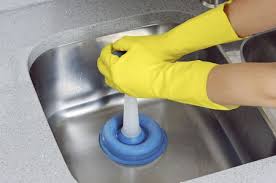
The Best Plunger For The Job
When it comes to plumbing repairs a clogged drain is one of the most common types of plumbing problems we see. Which is why having a plunger can be a lifesaver. But do you have the right plunger for the job? Did you know that there are different kinds of plungers? Many people are unaware that there a different kinds of plungers made for different types of drains. When it comes to plungers, it's not one size fits all. Not having the right plunger on hand can make your attempts at clearing a clog futile. Here are some plunger variations and their uses to help your find the best plunger for the job.
Cup Plunger
The cup plunger is the plunger you probably picture in your head when you think about a plunger. It is shaped like a cup, hence the name. Cup plungers are designed to clear flat drains like sinks, tubs, and showers. The cup forms a solid seal around the drain which allows for the best possible suction.
Flange Plunger
A flange plunger is basically a cup plunger, but with a lip at the end. This variation makes the flange plunger appropriate for round drains like toilets. The lip fits snugly into the drain, which allows for better suction. If you tried using a cup plunger on a toilet drain, there could be gaps around the seal, which means that the suction will not be as good. In order to clear a stubborn clog, you really need good suction.
Accordion Plunger
An accordion plunger is shaped just like and accordion with a small lip at the end. This type of plunger is also designed to clear toilet. While the accordion plunger takes a little more effort to use, it is highly effective at clearing a clog.
Tips for Using Your Plunger
When using your plunger it is important to make sure you are using your plunger correctly. This save a lot of time, energy, and helps your plunging efforts be more effective.
- Make Sure You Have a Good Seal - Having a good seal is going to make or break your plunging. A good seal allows for more suction and force, which you need in order to move a stubborn clog. This is why it is so important to make sure you are using the right plunger for the job.
- Make Sure Your Plunger Is Fully Submerged - You plunger will not work correctly and seal tightly if it isn’t fully submerged. You may have to pour some water into the sink or toilet.
- Get The Air Out of The Cup - Air trapped insight the cup can mess with your seal. To ensure that there isn’t any air trapped inside the cup, insert the plunger slowly.
- Plunge Straight and Vertical - It is important to plunge straight up and down, angling your plunger could affect your seal, making your plunging less effective.
- Warm Up Your Plunger With Warm Water Before - Warm water can make your plunger more pliable, enabling it to form a tighter seal around around the drain.
- Be Persistent - Sometimes you will face a clog that is really stubborn. In this instance you may need to plunge for longer intervals at a time. Hot water can also help loosen tough clogs, try running hot water down the drain before plunging. In addition, you may need to employ the use of an auger. Alternating between plunging and using the auger can also be effective. At the end of the day, if you are unable to clear the clog, then you should contact your plumber. There may be a more serious problem afoot.
For more plumbing tips, or to schedule a service appointment, contact Rooter Hero today!






